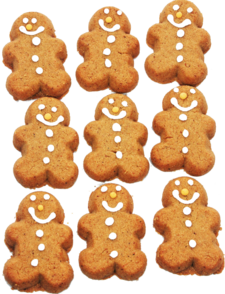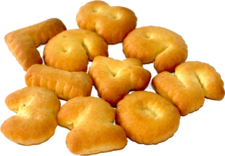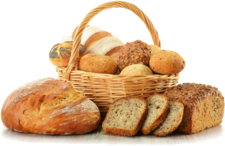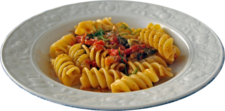Description
Dough is made simply by mixing flour with a liquid such as water or milk. Other ingredients are added to change or control characteristics such as Elasticity of the dough mixture or texture, colour and taste of the finished product. During mixing, individual Gluten proteins in the flour unravel and bond together to create a network of interconnected gluten strings which hold the dough together and give it its structure. Most recipes will use Plain or All-Purpose Flour, but some flours contain more gluten than others.
Ingredients
- Adding a little salt will neutralise electrically charged parts of the gluten allowing them to slide along one another to make a more elastic and stretchable dough. Salt Dough includes lots of salt which produces almost a modelling clay type material which is good for making painted tree ornaments but not really good to eat.
- Adding oil or butter can suppress the formation of gluten by coating the protein with fat - especially if oil or softened butter is added directly to the flour before the dough is formed. Such recipes are used for traditional flatbreads and pizza bases for example.
- Eggs add richness and colour to the mix. They add water which helps glutens develop but yolks contain a high percentage of fat, which like oil weakens gluten development. They also add their own proteins which are softer and less chewy than gluten proteins.
- Baking Soda, Baking Powder, and Yeast are added to create gas bubbles (i.e. Leavening Agents) which are trapped within the elastic dough and which set when cooked to give the product its texture.
- A small amount of sugar or other sweetening ingredient may help activate and feed any yeast present in the recipe. Adding more sugar or syrup will make the product sweeter, of course, but may also add colour and flavour depending on the type used.
- Additionally, various flavourings and spices can be added as required.
Recipe Quantities
UK recipes for home baking tend to provide amounts for the larger quantities (e.g. flour) in grams but use Cups, Tablespoon, Teaspoon, Drop, and Pinch as Weights and Measures.
These units are not well defined and there is significant variation between UK and US versions shown in recipes. This leaves scope for experimentation when using any published recipe, but the amounts can generally be approximated as follows:
| Unit
|
Metric UK
|
American
|
| Dry (grams)
|
Liquid (millilitre)
|
Dry (grams)
|
Liquid (millilitre)
|
| Flour
|
Sugar
|
Salt
|
Liquid (milk)
|
Flour
|
Sugar
|
Salt
|
Liquid (milk)
|
| * Cups
|
150
|
212
|
300
|
250
|
125
|
200
|
285
|
240
|
| * Tablespoon
|
8
|
13
|
18
|
15.5
|
8
|
12.5
|
18
|
15
|
| * Teaspoon
|
3
|
4
|
6
|
5
|
3
|
4
|
6
|
5
|
| * Drop
|
0.03
|
0.04
|
0.06
|
0.05
|
0.03
|
0.04
|
0.06
|
0.05
|
| * Pinch
|
0.12
|
0.16
|
0.3
|
0.25
|
0.12
|
0.16
|
0.3
|
0.25
|
Note:
The different dry weights are because of the different Densities of dry ingredients and how closely they are packed together. The Density of water is 1 (and milk almost the same) so if you think the ingredient would float then assume it to be less than one, and therefore proportionally less than the figure given for the liquid measure, and more if it would sink. For guidance the Densities of some common ingredients are: Flour (0.7); Salt (1.2); Butter (1.2); Sugar (0.9) - (e.g. a 250ml cup of milk x 1.2 = 300g of fine salt).
Bakers' Percentages
Using measures such Cups, Tablespoon, or Teaspoon may be quite adequate for the relatively small quantities used in domestic cooking but would be difficult to scale up for baking commercially. Professional bakers therefore tend to work with the proportion of each ingredient required in relation to the amount of flour and use what are known as the Baker percentages.
Any recipe can be converted to Baker percentages by dividing the weight of each ingredient by the weight of flour and multiplying by 100% as shown:
A common biscuit recipe therefore might be: 100% Plain Flour; 80% Softened Butter; 7% Egg Yolk; 50% Caster Sugar; 3% Vanilla Extract (a UK Standard Egg weighs about 60g without shell of which 20g is the Yolk)
Dough Recipes
Some basic recipes are described below but searching the internet will reveal many, many more.
(use for modelling : not suitable for eating)
- 300g Plain Flour
- 200g Water
- 350g Fine Salt
|
- Mix salt and flour together in a bowl
- Gradually stir in water until it forms a 'doughy' consistency.
- Knead on a firm surface until smooth.
- Hand model the dough, press into moulds or roll out and cut out shapes as needed (Salt Dough is not really edible).
- Place on a baking sheet and out into the oven at 180oC for 2 to 3 hours until dry (remember to poke holes through for hanging ornaments when still soft).
- Paint if required.
|
|
- 225g Plain Flour
- 100g Unsalted Butter
- 1.75g Bicarb of Soda
- 50g Brown Sugar
- 120g Golden Syrup
- 6g Ground Ginger
|
- Cream together the softened butter and sugar
- Add the flour, bi-carb of soda and ginger then beat together
- Add the syrup and beat until smooth
- Chill the mixture in the fridge for 15mins.
- Pre-heat oven to 180oC
- Roll out to 5mm to 10mm thickness on a lightly floured surface
- Cut out shapes and place on a baking sheet
- Bake for about 15 minutes or until golden brown.
- Allow to cool then decorate with icing or coloured sweets etc. (remember to poke holes through when still soft if needed)
|
|
- 200g Plain Flour
- 3g Salt
- 90g Softened Butter
- 60g Egg
- 2.25g Baking Powder
- 100g Caster Sugar
- 2.25g Vanilla Extract
|
- Cream together the softened butter and sugar then beat in the egg and vanilla extract
- Mix together the flour, baking powder, salt and add the mixture until a dough is formed
- Wrap the dough in cling-film and chill in the fridge for 60mins.
- Pre-heat oven to 170oC
- Roll out the dough to about 6-10mm thickness on a lightly floured surface and cut out shapes as required
- Place on a baking sheet and bake for 10-12mins or until golden brown
- Allow to cool then decorate with icing or coloured sweets etc. as required (remember to poke holes through when still soft if needed)
|
|
- 125g Plain Flour
- 30-45g Cold Water
- 0.3g Salt
- 55g Cubed Butter (cold)
|
- Place in a chilled bowl to rub together the flour, salt and butter.
- Stir in enough cold water with a round bladed knife.
- Form into a dough but handle as little as possible.
- Wrap the dough in cling-film and chill for 10-15 minutes.
- Roll out to about 6mm thickness on a lightly floured surface.
- Start to Blind Bake by laying the pastry sheet over a lightly greased flan case or similar.
- Carefully push down into the corners and try to thicken the edges a little by pressing down lightly, then trim to about 5mm sticking up.
- Prick all over the bottom with a fork, line with baking parchment and fill with dried peas or similar.
- Bake in an oven pre-heated to about 190oC for 12-15mins.
- Remove the baking parchment with dried peas, apply an egg wash and return to the oven for a little longer until golden brown.
|
|
- 300g Plain Flour
- 260g Milk
- 3g Salt
- 115g Softened Butter
- 120g Eggs
- 9g Baking Powder
- 160g Sugar
- 5g Vanilla Essence
|
- Pre-Heat oven to 190oC and line a Muffin Pan or Tray with papers.
- Cream together the butter and sugar then beat in eggs one at a time.
- Mixed together flour with baking powder and salt then add with milk and beat well
- Stir in vanilla essence and divide evenly among the muffin pans
- Bake for 18 minutes and leave to cool in the pans or trays.
- Decorate as needed with icing, sprinkles, coloured sweets, etc.
|
|
- 600g Plain Flour (Strong Bread Flour if available)
- 141g Water (warm)
- 6g Salt
- 60g Olive Oil (Extra-virgin)
- 14.5g Dry Yeast
- 4.2g sugar
|
- Stir warm water and yeast together in a warm mixing bowl then leave for a few minutes.
- Add salt and sugar and stir.
- Mix in flour and olive oil by hand until it can be kneaded without it sticking to fingers.
- Knead the dough for about 15mins.on a firm surface occasionally dusting with flour.
- Place the dough ball in a lightly oiled bowl, cover with a towel and leave in a warm place for about 2 hours to rise
- Cut into pieces then bake in an oven at 220oC for 25-30mins.
|
|
- 375g Plain Flour
- 225ml Water (warm - 45oC)
- 6g Salt
- 25g Olive Oil
- 7g Dried Baking Yeast
- 15g Caster Sugar
|
- Combine together the flour, salt, yeast and sugar in a mixing bowl.
- Mix in the oil and warm water to form a dough.
- Knead the dough for about 3-5mins.on a firm surface.
- Place the dough ball in a lightly oiled bowl, cover with a towel and leave in a warm place for about 1 hour to rise
- Pre-heat the oven to 230oC), together with any pizza stone or baking sheet.
- Cut into pieces and knock any air out
- Roll out and stretch into circles on a firm surface sprinkled with flour or Polenta
- Adding toppings and bake in an oven at 220oC for about 15mins.
|
|
- 140g Plain Flour
- 30g Water
- 3g Salt
- 60g Egg (beaten)
|
- Mix together the flour and salt either in a bowl or on a clean surface.
- Make a well in the centre and add the beaten egg.
- Use fingers or a fork to add flour to egg a little at a time.
- Add water as needed to form a stiff dough
- Knead the dough on a lightly floured surface for about 5mins or until smooth and elastic.
- Rest the dough for 10mins then cut into pieces and roll into thin sheets to be cut and shaped as needed.
- To cook the Pasta, bring a pan of lightly salted water to the boil, add the Pasta and cook for 2-3mins.
|
|








